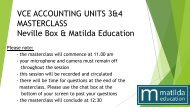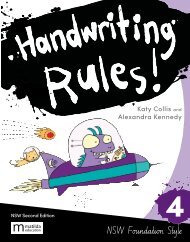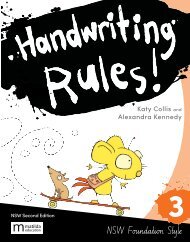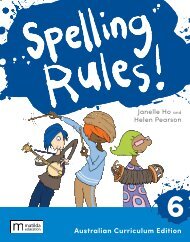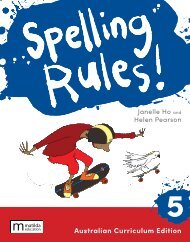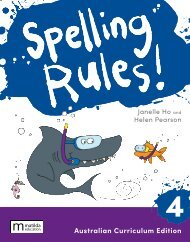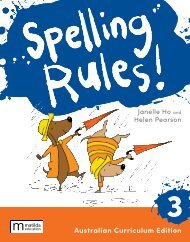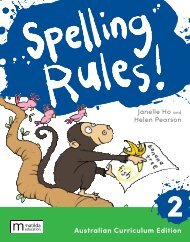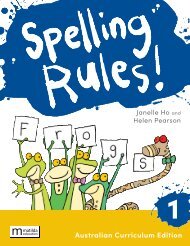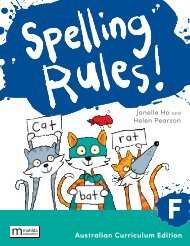Connecting Literacy Student Folio 1 Sample Pages
Connecting Literacy targets whole-school literacy improvement for Secondary students and teachers. What is Connecting Literacy? A developmental literacy program for Secondary schools, including: -3 student folios -3 teacher books -100s of video lessons hosted by literacy consultant, Hayley Harrison. Who is Connecting Literacy for? Secondary school students and teachers who: -are embarking on whole-school literacy improvement, OR -integrate literacy skills in the English classroom, OR -attend a timetabled literacy block. How does Connecting Literacy work? With cumulative skill development over three books where students: -Model: read and annotate an ‘anchor text’ – an authentic piece of student writing -Practise: complete units of work in class or as homework with video support from Hayley Harrison, literacy coach -Apply: draft their own text directly into the writing pages included in each student folio. Why do you need Connecting Literacy? -Flexibility: Use the series over three consecutive years or use the student folios in parallel to differentiate, support and extend. -Support: Video lessons, teacher books with answers and suggested programs, a literacy skills ‘toolkit’ and on-demand P.D. sessions will support experienced and out-of-discipline teachers alike. -Evidence: Student folios are designed as a learning pathway with built-in student reflection, metacognition and formative assessment (with developmental rubrics). -Whole-school: Use Connecting Literacy to underpin your whole school literacy plan and create a common metalanguage around literacy.
Connecting Literacy targets whole-school literacy improvement for Secondary students and teachers.
What is Connecting Literacy?
A developmental literacy program for Secondary schools, including:
-3 student folios
-3 teacher books
-100s of video lessons hosted by literacy consultant, Hayley Harrison.
Who is Connecting Literacy for?
Secondary school students and teachers who:
-are embarking on whole-school literacy improvement, OR
-integrate literacy skills in the English classroom, OR
-attend a timetabled literacy block.
How does Connecting Literacy work?
With cumulative skill development over three books where students:
-Model: read and annotate an ‘anchor text’ – an authentic piece of student writing
-Practise: complete units of work in class or as homework with video support from Hayley Harrison, literacy coach
-Apply: draft their own text directly into the writing pages included in each student folio.
Why do you need Connecting Literacy?
-Flexibility: Use the series over three consecutive years or use the student folios in parallel to differentiate, support and extend.
-Support: Video lessons, teacher books with answers and suggested programs, a literacy skills ‘toolkit’ and on-demand P.D. sessions will support experienced and out-of-discipline teachers alike.
-Evidence: Student folios are designed as a learning pathway with built-in student reflection, metacognition and formative assessment (with developmental rubrics).
-Whole-school: Use Connecting Literacy to underpin your whole school literacy plan and create a common metalanguage around literacy.
Create successful ePaper yourself
Turn your PDF publications into a flip-book with our unique Google optimized e-Paper software.
<strong>Connecting</strong><br />
<strong>Literacy</strong><br />
‘… eternal life gives time little meaning’<br />
Authored by<br />
Hayley<br />
Harrison<br />
and a team of students, just like you.<br />
<strong>Student</strong><br />
<strong>Folio</strong>
<strong>Connecting</strong><br />
<strong>Literacy</strong><br />
<strong>Student</strong><br />
<strong>Folio</strong><br />
Authored by<br />
Hayley<br />
Harrison<br />
and a team of students, just like you.<br />
‘… eternal life gives time little meaning ’
<strong>Connecting</strong> <strong>Literacy</strong><br />
<strong>Student</strong> <strong>Folio</strong> 1<br />
1st edition<br />
Hayley Harrison<br />
Publisher: Catherine Charles-Brown<br />
Project editor: Naomi Saligari<br />
Copy editor: Naomi Saligari<br />
Proofreader: Kelly Robinson<br />
Cover and text design: Ana Cosma (anacosma.com)<br />
Typesetter: Paul Ryan<br />
Illustrator: QBS Learning<br />
The author and publisher are grateful to the following<br />
for permission to reproduce copyright material:<br />
Cover: Getty Images/ Yasser Chalid<br />
Graph based on Australian Institute of Health and<br />
Welfare material, 98; iStockphoto/Danylyukk, 71<br />
(bottom), /darksite, 25 (bottom), /elenabs, 71 (top),<br />
/Holy Polygon, 25 (top), /PALMIHELP, 95,<br />
/Holy Polygon, 25 (top), Syntika, 25.<br />
Every effort has been made to identify copyright<br />
holders and obtain their permission for the use of<br />
copyright material. We actively solicit copyright<br />
holders or anyone with knowledge of copyright<br />
holders to come forward.<br />
Warning: It is recommended that Aboriginal and<br />
Torres Strait Islander peoples exercise caution when<br />
viewing this publication as it may contain images of<br />
deceased persons.<br />
Matilda Education Australia acknowledges all Aboriginal<br />
and Torres Strait Islander Traditional Custodians of<br />
Country and recognises their continuing connection to<br />
land, sea, culture, and community. We pay our respects<br />
to Elders past and present.<br />
First published in 2023 by Matilda Education Australia,<br />
an imprint of Meanwhile Education Pty Ltd<br />
Melbourne, Australia<br />
T: 1300 277 235<br />
E: customersupport@matildaed.com.au<br />
www.matildaeducation.com.au<br />
Copyright © Hayley Harrison 2023<br />
Copyright © Matilda Education 2023<br />
The moral rights of the authors have been asserted.<br />
All rights reserved. Except under the conditions<br />
described in the Copyright Act 1968 of Australia<br />
(the Act) and subsequent amendments, no part of<br />
this publication may be reproduced, in any form or<br />
by any means, without the prior written permission<br />
of the copyright owner.<br />
Educational institutions copying any part of this book<br />
for educational purposes under the Act must be<br />
covered by a Copyright Agency Limited (CAL) licence<br />
for educational institutions and must have given<br />
a remuneration notice to CAL.<br />
These limitations include: restricting the copying<br />
to a maximum of one chapter or 10% of this book,<br />
whichever is greater. For details of the CAL licence<br />
for educational institutions, please contact:<br />
Copyright Agency Limited<br />
Level 11, 66 Goulburn Street<br />
Sydney, NSW 2000<br />
Toll-free phone number (landlines only): 1800066844<br />
Telephone: (02) 9394 7600<br />
Fax (02) 9394 7601.<br />
Email: memberservices@copyright.com.au<br />
Website: https://www.copyright.com.au<br />
Publication data<br />
Author: Hayley Harrison<br />
Title: <strong>Connecting</strong> <strong>Literacy</strong> <strong>Student</strong> <strong>Folio</strong> 1<br />
ISBN: 9780655091417<br />
A catalogue record for this<br />
book is available from the<br />
National Library of Australia<br />
Printed in Malaysia by Vivar Printing<br />
Oct-2022
<strong>Connecting</strong><br />
<strong>Literacy</strong><br />
Contents<br />
Introduction to literacy .........................<br />
iv<br />
Unit 1: Persuasive literacy ..................... 2<br />
Unit 2: Procedural literacy ..................... 24<br />
Unit 3: Imaginative literacy .................... 48<br />
Unit 4: Informative literacy .................... 70<br />
Unit 5: Analytical literacy ...................... 94<br />
Unit 6: Reflective literacy ...................... 118<br />
Unit 7: Comparative literacy .................. 140<br />
<strong>Literacy</strong> How-to .................................. 164<br />
Comprehension ............................... 164<br />
Planning and writing ......................... 167<br />
Structures and features ...................... 174<br />
Vocabulary ..................................... 181<br />
Syntax ........................................... 183<br />
Punctuation .................................... 188<br />
Spelling ......................................... 191<br />
Speaking and listening ....................... 200<br />
Introduction to literacy<br />
iii
Introduction to literacy<br />
<strong>Literacy</strong> is a complex amalgamation of skills that interweave and are applied when<br />
reading, writing, speaking, and listening. The goal of systematically and explicitly<br />
teaching individual literacy skills is to increase the effectiveness and efficiency of<br />
students’ communication. Mastering literacy skills requires a person to understand,<br />
consolidate, and build automaticity in individual skills and then combine these skills<br />
to develop as a critical reader, coherent writer, and confident speaker.<br />
The literacy skills and strategies presented in this book are designed to be individually<br />
taught, explored, consolidated, and built upon. This learning is then explicitly transferred<br />
beyond the classroom to help students in every part of their school and everyday<br />
lives. Teaching is supported by an instructional model that consists of prior knowledge<br />
activation, explicit teaching, collaboration, independent practise, and reflection. There<br />
are layers of teaching and learning support, including links to comprehension strategies,<br />
writing organisers, and formative assessment opportunities at a lesson and unit level.<br />
How to use <strong>Connecting</strong> <strong>Literacy</strong>: Model, practise, apply<br />
This book is divided into seven units – which are based on the different text types that students<br />
will encounter during school and beyond – and one <strong>Literacy</strong> How-to section, which is a complete<br />
reference guide that can be referred to throughout the book:<br />
• Unit 1: Persuasive literacy<br />
• Unit 2: Procedural literacy<br />
• Unit 3: Imaginative literacy<br />
• Unit 4: Informative literacy<br />
• Unit 5: Analytical literacy<br />
• Unit 6: Reflective literacy<br />
• Unit 7: Comparative literacy<br />
• <strong>Literacy</strong> How-to section.<br />
In each unit, the students model, practise, and apply specific literacy skills to a different text type.<br />
Model<br />
Each of the seven units begins with an anchor text. Each anchor text is a model that is<br />
designed to ‘anchor’ the students’ learning as they complete the activities in the unit.<br />
The anchor texts in this series were all written by students in years 7–10, from schools<br />
across Australia.<br />
Practise<br />
Each unit has eight lessons that focus on core literacy skills and strategies:<br />
1 comprehension<br />
5 syntax<br />
2 planning and writing<br />
6 punctuation<br />
3 structures and features<br />
7 spelling<br />
4 vocabulary<br />
8 speaking and listening.<br />
At the end of the book, there is a <strong>Literacy</strong> How-to section. This is a comprehensive<br />
literacy reference guide that is designed to support teachers and students by providing<br />
content, skills, and strategies that can be applied across the units. This section is<br />
designed to connect with prior knowledge activation, and to provide opportunities<br />
for clarification and extension of understanding and skill development.<br />
iv <strong>Connecting</strong> <strong>Literacy</strong> • Book 1
Apply<br />
In each lesson, comprehension strategies are suggested to help the students to complete the<br />
activities successfully. Each unit includes writing pages for students to use to draft and edit their<br />
own original texts. By containing their learning and application in the same book, students can<br />
build a comprehensive learning folio.<br />
STRATEGY<br />
Pause to<br />
wonder and<br />
connect.<br />
<strong>Connecting</strong> <strong>Literacy</strong><br />
Model, practise, apply<br />
Comparative texts<br />
SPEAKING &<br />
LISTENING<br />
3 Apply<br />
MY WRITING PAGES<br />
2 Practise<br />
COMPREHENSION<br />
Persuasive texts<br />
Refllective texts<br />
SPELLING<br />
PUNCTUATION<br />
1 Model<br />
ANCHOR TEXT<br />
A model text written<br />
by a student,<br />
just like you<br />
PLANNING &<br />
WRITING<br />
STRUCTURES &<br />
FEATURES<br />
Procedural texts<br />
Analytical texts<br />
SYNTAX<br />
VOCABULARY<br />
Imaginative texts<br />
Informative texts<br />
LITERACY HOW-TO<br />
Your go-to literacy reference guide, to support your every step<br />
Reflect<br />
Unit confidence scores: At the start of each unit, students are invited to rate their confidence about<br />
reading, writing, speaking, and listening to the particular text type. The intention is that students will<br />
return at the end of the unit to score their learning confidence again and to celebrate their success.<br />
Lesson confidence scores: Every lesson in the <strong>Connecting</strong> <strong>Literacy</strong> series culminates in students<br />
giving themselves a score out of five: this self-assessment promotes students’ awareness of their<br />
learning and understanding. This self-assessment also provides an opportunity for teachers to note<br />
any areas that require further class time or clarification.<br />
The students’ learning in each unit is brought together with a learning ladder. Using this chart,<br />
the students can self-assess their final writing and speaking and listening task (these tasks have<br />
a speaking and listening icon in the margin) and reflect on their learning throughout the unit.<br />
Introduction to literacy<br />
v
Persuasive literacy<br />
http://mea.<br />
digital/CL1_1_0<br />
Being persuasive involves convincing another person, or a group of people, to do something<br />
or to agree with you about something. Developing your literacy skills in this area will help<br />
you to read, write, speak, and listen to texts that powerfully express an opinion or point of<br />
view. Persuasive texts use various techniques to convince the audience; the author carefully<br />
selects the techniques that will have the most impact on the audience. Persuasive texts are<br />
non-fiction and can be written, spoken, or multimodal. Many different types of texts can be<br />
persuasive, including speeches, presentations, flyers, blogs, and podcasts.<br />
Why do we create persuasive texts?<br />
Persuasive texts are created to cause action: they are written to inspire people to do something or<br />
to actively agree with a point of view. These texts try to make the reader or audience agree with<br />
what is being presented. Persuasive texts usually cover topics that the writer or speaker is passionate<br />
about. Who a text is created for changes the type of language and persuasive devices used by the<br />
author. A persuasive email written to a teacher should sound very different from a persuasive text<br />
message written to a friend.<br />
1 Use your own words to describe persuasive writing.<br />
2 List some persuasive texts you might be asked to read, listen to, or write in different school subjects.<br />
Page 3<br />
3 Read the anchor text. This text is a model that will help you to ‘anchor’ your learning as you<br />
complete the activities in this unit. It will also assist you to draft your own persuasive speech.<br />
The anchor text was written by a student, just like you.<br />
Rate my<br />
confidence<br />
At the end of each lesson, you will rate how confident you are about your<br />
progress through the unit. Be as honest as you can; it’s your learning!<br />
4 How confident do you currently feel about reading, writing, speaking, and listening to persuasive<br />
texts? Give yourself a confidence score out of five. Come back at the end of the unit to score your<br />
learning confidence again.<br />
Start of the unit: DD \ MM \ YYYY<br />
End of the unit: DD \ MM \ YYYY<br />
1 2 3 4 5<br />
1 2 3 4 5<br />
Not very<br />
confident<br />
Somewhat<br />
confident<br />
Confident<br />
Highly<br />
confident<br />
Super<br />
confident<br />
Not very<br />
confident<br />
Somewhat<br />
confident<br />
Confident<br />
Highly<br />
confident<br />
Super<br />
confident<br />
2 <strong>Connecting</strong> <strong>Literacy</strong> • Book 1
Anchor text<br />
Persuasive speech<br />
Will streaming services replace cinemas?<br />
Netflix. Disney+. Amazon Prime. A few years ago, no-one even knew that these services<br />
were possible! Yet now our future seems to be overflowing with options. So, what does this<br />
mean for the humble cinema? Hello friends, as you know, my name is Kathleen and I’m here<br />
today to show you that, while cinemas will stay a luxury, streaming platforms should be,<br />
and ultimately will be, the unrivalled way to watch movies. ‘Why?’ you may ask.<br />
Well, for starters, it is way more affordable. The average price of a student movie ticket is<br />
around $18. A basic Netflix subscription is $11 per month – almost half the price for a wider<br />
catalogue of movies for a whole month. What a scam! Why would we spend double the<br />
amount of money to watch one movie, when we could watch as many movies as we want<br />
from the comfort of our own home? It just doesn’t make any sense …<br />
Adding to this, the cinema experience is not as lenient or flexible as the streaming<br />
experience. It can be hard to find time for entertainment in our busy lives. The limited<br />
showing times in movie theatres can be an annoying and unnecessary problem for people<br />
to work around. But with Disney+ or Binge, we can watch movies whenever and wherever<br />
we please. We can also stop and start the film, or re-watch parts again – none of which<br />
you can do in a cinema! So, whether it is midnight in bed, or during your morning bathroom<br />
routine, online streaming provides the convenience and comfort that cinemas simply cannot!<br />
But some think that cinemas provide the ‘irreplaceable’ experience of a popcornstenched<br />
room. And sure, getting dressed up and going out with friends and having<br />
a shared experience is always fun. However, most people know this is not always a<br />
reality. For families, it can be a nightmare – spilled snacks, untimely toilet trips, and short<br />
attention spans. Not to fear! Streaming at home can prevent this, and it also allows people<br />
with disabilities to accommodate their needs through subtitles and appropriate seating.<br />
Its inclusivity allows everyone to be able to enjoy films the way that suits them best,<br />
and we all want that, don’t we?<br />
Streaming services have given everyone a better way to indulge in the art of film.<br />
The cinema, in contrast, is an expensive and restrictive luxury that only suits a small<br />
percentage of the population. I don’t believe the debate is whether streaming services<br />
will replace cinemas – we’ve already embraced the change from theatres to our TVs and<br />
laptops – today I want you to feel comfortable in accepting these services as a positive<br />
replacement to the antiquated cinema. So, the only question left is: who’s ready for another<br />
binge session?<br />
<strong>Student</strong> author: Kathleen Pham<br />
Audience: Kathleen’s class<br />
http://mea.digital/<br />
CL1_1_A<br />
Persuasive literacy ~ Unit 1 3
1.1<br />
L E A R N I N G<br />
I N T E N T I O N :<br />
Persuasive comprehension<br />
To understand the overall<br />
purpose of a persuasive text<br />
Part A: Question the text<br />
http://mea.digital/<br />
CL1_1_1<br />
Page 3<br />
One way to deeply explore any text is to question the text. Asking questions can help you to uncover<br />
parts of the text that might not have made sense, or to notice things you might have missed, when<br />
reading or hearing the text for the first time.<br />
Read the anchor text and then answer the following questions.<br />
1 What question is the anchor text answering?<br />
2 What does the author mean when she says that ‘cinemas will stay a luxury’?<br />
3 Why did the author say that a movie ticket costing $18 is ‘a scam’?<br />
STRATEGY<br />
Re-read the<br />
text at a slower<br />
pace to search<br />
for specific<br />
information.<br />
4 The author describes the cinema as a ‘popcorn-stenched room’.<br />
a How does this description make the audience feel about the cinema?<br />
b Why do you think the author chose to describe a cinema this way?<br />
5 What other questions could you ask to better understand the anchor text? Try to think of three<br />
questions. Start each question with a different question word.<br />
Part B: Contention and intention<br />
Page 164<br />
Comprehension<br />
strategies<br />
A persuasive text tries to convince the reader or audience to think something or to do something.<br />
Every persuasive text contains a contention and an intention:<br />
• a text’s contention is the overall thing the author wants you to think (the main idea)<br />
• a text’s intention is what the author wants you to do (the call to action).<br />
One way to identify a text’s contention is to pick out the arguments. This is because all the<br />
arguments in a text combine to make the text’s contention. Evidence is used to support<br />
the arguments.<br />
4 <strong>Connecting</strong> <strong>Literacy</strong> • Book 1
For example, imagine a persuasive speech that answers the question, ‘Are books better than<br />
television?’; this speech argues that books are superior to television. The contention and intention<br />
of this speech are:<br />
Contention<br />
(the main idea)<br />
Intention<br />
(the call to action)<br />
Books are more detailed, use imagination, and do not need electricity,<br />
which makes them far superior to television.<br />
Turn off the television and read more books.<br />
6 Annotate the anchor text by numbering the paragraphs.<br />
7 Identify the three main arguments presented in paragraphs two, three and four of the anchor text.<br />
Give each argument a short label (use one to four words) to explain what the argument is trying to<br />
make us think.<br />
a Argument one:<br />
Page 3<br />
STRATEGY<br />
Identify and<br />
understand<br />
the pieces<br />
of the text.<br />
b Argument two:<br />
c Argument three:<br />
8 Combine all the arguments into one overall idea. What is the anchor text’s contention?<br />
Contention (the main idea): Streaming services are …<br />
9 Search the anchor text to find out what the author is directly asking the audience to do. What is the<br />
text’s intention?<br />
Intention (the call to action): The author wants the audience to …<br />
10 For each of the three arguments you identified in the anchor text, underline the specific evidence<br />
the author uses to support that argument.<br />
For example: Underline ‘The average price of a student movie ticket is around $18. A basic Netflix<br />
subscription is $11 per month’.<br />
11 Overall, how has the anchor text answered the question it was responding to?<br />
I understand the overall purpose of a persuasive text: ______ / 5<br />
How many times this week can you question a text you are reading? Keep this strategy<br />
at the front of your mind in other subjects and you will be amazed how many times you<br />
use it.<br />
TAKE IT<br />
WITH YOU<br />
1.1 Persuasive comprehension 5
1.2<br />
Persuasive planning and writing<br />
Part A: Develop your arguments<br />
L E A R N I N G<br />
I N T E N T I O N :<br />
To understand how<br />
to plan and develop<br />
my persuasive speech<br />
http://mea.digital/<br />
CL1_1_2<br />
Page 20<br />
Authors use multiple arguments to build towards their contention. It is important when you are<br />
planning your own persuasive texts to not just think about separate arguments but how you can<br />
connect the arguments to build your contention.<br />
Your writing task for this unit is to write a short speech, which will be similar to the<br />
anchor text in purpose, audience and length. In this speech, you will present your opinion<br />
on the following question:<br />
Will the future be better than the past?<br />
1 Use the network tree in Figure 1.1 below to brainstorm different ways the future could, and could<br />
not, be better than the past.<br />
Will the FUTURE be better than the PAST?<br />
Page 167<br />
Brainstorming,<br />
researching,<br />
and planning<br />
Yes<br />
No<br />
Figure 1.1<br />
2 Using your filled-in network tree as a guide, decide whether you think the future or the past<br />
is better.<br />
3 Identify two arguments you will use in your speech.<br />
a Argument one<br />
b Argument two<br />
4 Using your arguments, determine the contention of your speech.<br />
Contention (the main idea): The future will be/The past is better than the past/future because …<br />
6 <strong>Connecting</strong> <strong>Literacy</strong> • Book 1
Part B: Revise your text for your audience and purpose<br />
You are writing a speech to present to your class, so you want to make sure that it is persuasive and<br />
engaging. Try to connect your thinking with their thinking so your speech means as much as possible<br />
to your audience.<br />
5 What do you want your classmates to do after listening to your speech? What is your intention<br />
(call to action)?<br />
Intention (call to action):<br />
STRATEGY<br />
Understand<br />
the purpose<br />
of the text<br />
or feature.<br />
6 What kinds of things are your classmates currently interested in? (Think about your class overall:<br />
Which big topics are the most important to your classmates? What are they most passionate about?)<br />
7 What evidence could you use to support the two arguments you identified in Question 3? Think<br />
about what evidence will mean the most to your classmates and will connect to your classmates<br />
most effectively. (You might be able to use some of the ideas you brainstormed in Question 6 if<br />
they support your arguments.)<br />
Arguments<br />
Evidence<br />
Argument one:<br />
Page 172<br />
Finding<br />
appropriate<br />
evidence<br />
Argument two:<br />
Page 20<br />
8 Using the anchor text as a model and the arguments and evidence you identified in Question 7,<br />
write a draft of your speech. You can write your draft in the writing pages at the end of this unit.<br />
We will continue to revise your speech throughout the unit, so for now, write the first draft, knowing<br />
it doesn’t have to be perfect, but it is enough to start experimenting with.<br />
Page 172<br />
Turning a plan<br />
into a draft<br />
I understand how to plan and develop my persuasive speech: ______ / 5<br />
Beyond the English classroom, where else is it important to keep the audience and<br />
purpose of your writing in mind? Note the impact this has on your planning and writing<br />
in other subjects.<br />
TAKE IT<br />
WITH YOU<br />
1.2 Persuasive planning and writing 7
1.3<br />
Persuasive structures<br />
and features<br />
L E A R N I N G<br />
I N T E N T I O N :<br />
To understand the key structural<br />
elements and language features<br />
of persuasive speeches<br />
Part A: Persuasive speeches<br />
http://mea.digital/<br />
CL1_1_3<br />
One of the most powerful forms of persuasion is to present your ideas orally, which means speaking<br />
persuasively. Often, we plan a persuasive speech in a similar way to an essay or a report: we brainstorm<br />
our key ideas, identify our overall intention, and ensure we have specific evidence to support each<br />
idea. However, while the planning process is similar, writing a speech is different to writing an essay.<br />
1 Identify and label the following structural elements of a speech in the anchor text.<br />
Page 3<br />
STRATEGY<br />
Annotate and<br />
make notes.<br />
a The opening or introduction (paragraph one):<br />
• an engaging hook (a question, fact, anecdote, or statement to interest the audience)<br />
• an introduction of the topic (the question or issue being addressed)<br />
• an introduction of the speaker<br />
• an introduction of the contention<br />
b The body (paragraphs two and three):<br />
• an introduction of the key arguments<br />
• evidence to support the arguments<br />
• an explanation of how the arguments prove the contention<br />
c The rebuttal (paragraph four):<br />
• the alternative perspective<br />
d The closing or conclusion (paragraph five):<br />
• a synthesis of the arguments in the contention<br />
• the intention is made clear<br />
• the alternative perspective disproven<br />
• a final, memorable statement.<br />
Page 174<br />
Text forms<br />
2 Highlight and label one example of each of the following language features of a speech<br />
in the anchor text:<br />
• first-person perspective<br />
• shift in tone<br />
• present tense<br />
• signposts and transitions<br />
• speaking directly • persuasive devices<br />
• pause for effect (punctuation) to the audience<br />
(see Part B).<br />
3 Explain how the following structural elements and language features are either similar or different<br />
in a persuasive speech and a persuasive essay.<br />
Structural elements and<br />
language features<br />
How are these elements and features similar or different<br />
in a persuasive speech and essay?<br />
The overall structure (introduction,<br />
body, and conclusion)<br />
The language features (tense,<br />
vocabulary, tone, narrative<br />
perspective, and devices)<br />
How the evidence is used (quotes,<br />
types of evidence, and where and<br />
how the evidence is used)<br />
8 <strong>Connecting</strong> <strong>Literacy</strong> • Book 1
Part B: Persuasive devices<br />
A persuasive device is a language technique that helps to sway the reader or audience to agree with<br />
the author. The key persuasive devices that work best in spoken language include:<br />
• rhetorical questions: asking a question with an implied answer (look for a question mark)<br />
• inclusive language: using words that imply the audience members agree (look for words such as<br />
‘we’, ‘us’ and ‘together’)<br />
• emotive language: using words with strong connotations that make the audience feel something<br />
(look for descriptive words).<br />
4 Identify an example of each of the following in the anchor text.<br />
a Rhetorical question:<br />
b Inclusive language:<br />
Page 3<br />
c Emotive language:<br />
5 Read the following examples of other persuasive devices used in the anchor text. Explain what<br />
effect each device has on the speech.<br />
Persuasive<br />
device<br />
Generalisation<br />
Alliteration<br />
Rule of three<br />
How to find it<br />
in a text<br />
Look for<br />
words such as<br />
most, every,<br />
all, everyone,<br />
nobody.<br />
Look for more<br />
than two words<br />
that start with<br />
the same letter<br />
in the same<br />
sentence.<br />
Look for<br />
commas<br />
separating<br />
three words or<br />
phrases in the<br />
same sentence.<br />
Example from the<br />
anchor text<br />
‘However, most people<br />
know this is not always<br />
a reality.’<br />
‘… online streaming<br />
provides the<br />
convenience and<br />
comfort that cinemas<br />
simply cannot!’<br />
‘For families, it can be<br />
a nightmare – spilled<br />
snacks, untimely<br />
toilet trips, and short<br />
attention spans.’<br />
What effect does the<br />
device have?<br />
STRATEGY<br />
Pause to<br />
wonder and<br />
connect.<br />
6 What other persuasive devices can you find in the anchor text?<br />
7 Identify the structural elements and language features in your speech. How could you make your<br />
speech more persuasive? What other persuasive devices could you use? Revise your draft.<br />
I understand the key structural elements and language features of persuasive speeches: ______ / 5<br />
All kinds of texts have identifiable structural elements and language features.<br />
See how many you can spot in other classes and different texts!<br />
TAKE IT<br />
WITH YOU<br />
1.3 Persuasive structures and features 9
1.4<br />
L E A R N I N G<br />
Persuasive vocabulary<br />
I N T E N T I O N :<br />
To understand emotive language,<br />
denotation, and connotation<br />
in persuasive writing<br />
Part A: Emotive language<br />
http://mea.digital/<br />
CL1_1_4<br />
STRATEGY<br />
Connect to<br />
the feeling<br />
of the word.<br />
Persuasive people are passionate people who care enough about a topic that they want other<br />
people to agree with them. Writers use emotive language to express their feelings. Emotive<br />
language makes a person feel something. Emotive words build sensory imagery and appeal to<br />
people emotionally (rather than rationally). If you can identify the emotion connected to a word,<br />
you can ‘hear’ the tone in a piece of writing and ‘see’ the writer’s emotional perspective.<br />
1 Match each of the words in the table below with the emotion it best evokes.<br />
disgust, pity, distrust, confident, embarrassed, hurt, confused, fear<br />
Word<br />
Victims<br />
Ashamed<br />
Disillusioned<br />
Dangerous<br />
Betrayed<br />
Successful<br />
Pathetic<br />
Perplexed<br />
Emotion<br />
2 Highlight the emotive language used in the conclusion of the anchor text.<br />
Page 3<br />
3 Identify two words to describe how the anchor text made you feel.<br />
a The writer made me feel ____________________________________ about cinemas.<br />
b The writer made me feel ____________________________________ about streaming services.<br />
Part B: Denotation and connotation<br />
The meaning of every word can be specifically defined. This is called the denotation of a word<br />
(the literal meaning). The connotation of a word is very closely linked to emotive language,<br />
because it is the feeling a word evokes in a person.<br />
Denotation<br />
Connotation<br />
The standard definition of a word; its literal meaning<br />
The feeling evoked by a word<br />
Every word either has a positive, negative, or neutral connotation. If you find identifying the emotion<br />
of a word difficult, the first step is to think about whether it is positive or negative.<br />
10 <strong>Connecting</strong> <strong>Literacy</strong> • Book 1
4 a Does ‘victim’ make a person sound positive, negative, or neutral?<br />
b Does ‘champion’ make a person sound positive, negative, or neutral?<br />
5 In the table below, provide a simple denotation (definition) for each emotive word from the<br />
anchor text. Then decide if the connotation of each word is positive or negative.<br />
Emotive word Denotation (definition) Connotation<br />
Page 3<br />
Luxury<br />
Unrivalled<br />
Lenient<br />
Convenience<br />
Irreplaceable<br />
Antiquated<br />
6 In the sentences below, the bolded words have negative connotations. Replace each bolded term<br />
with a word that has a positive connotation.<br />
a The manipulative teacher forced his new policy on the victims of the school.<br />
Page 181<br />
Word meanings<br />
b Vulnerable children continue to be trapped in despicable conditions.<br />
c The unjustified decision to destroy the school’s statue repulsed students.<br />
7 a How is a word’s connotation powerful?<br />
b What is the importance of a word’s connotation in persuasive writing?<br />
8 How do you want your audience to feel during your speech?<br />
9 Revise your speech to appeal to your audience’s feelings. Experiment with your language choices<br />
to make them more emotive. Include more descriptive words so your audience knows how to feel<br />
about what you are talking about.<br />
Page 20<br />
I understand emotive language, denotation, and connotation in persuasive writing: ______ / 5<br />
How is emotive language used in texts other than persuasive speeches? Challenge<br />
yourself to identify positive or negative language in every text you read this week.<br />
TAKE IT<br />
WITH YOU<br />
1.4 Persuasive vocabulary 11
1.5<br />
Persuasive syntax<br />
L E A R N I N G<br />
I N T E N T I O N :<br />
To understand the differences between<br />
spoken and written language, including<br />
maintaining the subject–verb agreement<br />
Part A: Spoken versus written language<br />
http://mea.digital/<br />
CL1_1_5<br />
Page 202<br />
Spoken versus<br />
written language<br />
STRATEGY<br />
Connect with<br />
the language<br />
choices.<br />
We know that our language changes depending on our audience and purpose. We also use different<br />
language (particularly syntax or sentence structure) when we speak and when we write. However,<br />
speeches are different because they are written texts that are created to be spoken.<br />
1 Read the descriptions in the table below and decide which column is describing spoken language<br />
and which column is describing written language.<br />
• Is older, more informal, and simple<br />
• Is mostly used between people in the<br />
same place<br />
• Uses tone, pitch, volume, and intonation to<br />
express emotions and ideas<br />
• Is often temporary (unless recorded)<br />
• Is often improvised and formulated on the spot<br />
• Is not always clear or succinct; it often<br />
includes repetitions, incomplete sentences,<br />
interruptions, and self-corrections<br />
• Is younger, more formal, and complex<br />
• Can communicate across time and space<br />
• Uses headings, punctuation, layout, and<br />
symbols to express emotions and ideas<br />
• Is often permanent (unless deleted)<br />
• Is often organised and formulated; it is<br />
edited for clarity<br />
• Is as clear and succinct as possible; it is<br />
often grammatically correct<br />
2 How would you describe the similarities and differences between spoken and written language?<br />
3 Think about when you are writing a text that is intended to be read aloud or spoken (a speech).<br />
How is your writing different to when you are writing a text that is not intended to be spoken?<br />
Page 3<br />
4 How have the following sentences in the anchor text been written to make them sound more like<br />
the way a person speaks?<br />
a ‘ “Why?” you may ask.’<br />
b ‘Not to fear!’<br />
5 Turn each of the following sentences into a sentence that sounds more like the way a person speaks.<br />
a The future being faced is bleak.<br />
b By learning from past mistakes, the future looks bright.<br />
12 <strong>Connecting</strong> <strong>Literacy</strong> • Book 1
Part B: Subject–verb agreement<br />
Every sentence needs a subject (someone or something doing something) and a predicate (which<br />
includes a main verb to show what the subject is doing).<br />
In English sentences, the subject and the verb must ‘agree’ with each other. What this means is:<br />
• if a subject is singular (one), the verb must also be singular<br />
• if a subject is a plural (more than one), the verb must also be plural.<br />
For example: Singular subject and verb: The writer argues the point.<br />
Plural subject and verb: The writers argue their point.<br />
Page 186<br />
Subject and<br />
predicate<br />
6 Sort the following subjects and verbs into singular and plural.<br />
writers<br />
writer<br />
child<br />
children<br />
they<br />
he<br />
woman<br />
women<br />
has<br />
have<br />
is<br />
are<br />
argue<br />
argues<br />
was<br />
were<br />
Singular subject<br />
Plural subject<br />
Singular verb<br />
Plural verb<br />
STRATEGY<br />
Connect the<br />
subject and<br />
predicate.<br />
7 Underline the subjects in the following sentence and circle the verbs.<br />
When the subject disagree with the verb it confuse the reader.<br />
8 What revisions would you make in the sentence above to make the subjects and verbs agree?<br />
9 Does your speech read like a text that is intended to be spoken? How can you find the balance<br />
between writing formally and writing a text that is intended to be spoken to your class? Make sure<br />
your subjects and verbs all agree!<br />
Page 20<br />
I understand the differences between spoken and written language,<br />
including maintaining the subject–verb agreement: ______ / 5<br />
Spoken and written language are quite different, but the subjects and verbs should<br />
always agree. How often do you stop and check if your subjects and verbs agree when<br />
writing in other subjects? Pay attention to subject–verb agreement in Science, Maths,<br />
Geography or History this week and notice how your writing improves.<br />
TAKE IT<br />
WITH YOU<br />
1.5 Persuasive syntax 13
1.6<br />
L E A R N I N G<br />
Persuasive punctuation<br />
I N T E N T I O N :<br />
To understand the impact<br />
exclamation and question<br />
marks have on a written text<br />
Part A: Exclamation marks!<br />
http://mea.digital/<br />
CL1_1_6<br />
Page 188<br />
Types of<br />
punctuation<br />
An exclamation mark lets a reader know they should add emphasis to a sentence; this punctuation<br />
mark generally shows shock or surprise. An exclamation mark can also indicate a strong command<br />
or an emphasised show of emotion:<br />
• a strong command shows a firm and direct order<br />
For example: Swim at your own risk! Don’t touch! Watch out!<br />
• an emphasised show of emotion makes the emotion clearer.<br />
For example: That’s horrible! That’s awesome!<br />
1 Match each statement below with the emotion it is emphasising.<br />
excitement, astonishment, shock, vehemence, urgency<br />
What a terrible accident!<br />
This is a fantastic idea!<br />
Watch out! This is not going to last!<br />
That company is pure evil!<br />
Look at what has been achieved!<br />
STRATEGY<br />
Connect the<br />
punctuation<br />
to what is<br />
being said.<br />
2 Read the exclamations from the anchor text below. What is the exclamation mark showing?<br />
a ‘A few years ago, no-one even knew that these services were possible!’<br />
b ‘What a scam!’<br />
Page 3<br />
c ‘Not to fear!’<br />
3 Write a sentence, using an exclamation mark, to show each of the following emotions.<br />
a Anger:<br />
b Excitement:<br />
c Confusion:<br />
Part B: Question marks?<br />
A question mark is used to show that a direct question has been asked. It allows you to show doubt<br />
and it lets you know that something needs an answer. When you speak, your voice naturally rises in<br />
pitch at the end of a question. This is a signal to the person you are talking with that you’re looking<br />
for an answer. When it comes to the written word, the question mark does the same thing as your<br />
tone of voice: it sends the same signal.<br />
14 <strong>Connecting</strong> <strong>Literacy</strong> • Book 1
4 Write sentences to show your understanding of the following uses of the question mark.<br />
a A question mark can be used to express doubt.<br />
b A question mark can be used to show that a sentence is a direct question.<br />
c A question mark is placed at the end of a sentence.<br />
d A question mark should not be used for an indirect question.<br />
5 Match each of the following rhetorical questions from the anchor text to the impact the question<br />
has on the audience.<br />
Rhetorical questions from the<br />
anchor text<br />
‘So, what does this mean for the<br />
humble cinema?’<br />
Impact of the questions on the audience<br />
Page 3<br />
‘… and we all want that, don’t we?’<br />
‘… who’s ready for another binge<br />
session?’<br />
A question mark should be placed inside the quotation marks if it is a part of the quote and outside<br />
the quotation marks if it is part of the sentence.<br />
6 Decide whether the question mark goes inside or outside the quotation marks in the following<br />
sentences.<br />
a People are always asking, ‘What will the future be like’<br />
b What does anyone mean when they say, ‘The future is doomed’<br />
c So then she asked, ‘Why look back or forward when you can see the present’<br />
7 a Revise your speech to use exclamation marks to evoke different emotions. Although the audience<br />
won’t see them, they will help you use the right tone when speaking.<br />
b Rhetorical questions are compelling in persuasive writing. Have you used any rhetorical questions<br />
in your speech? Revise your speech to include at least one.<br />
Page 20<br />
I understand the impact exclamation and question marks have on a written text: ______ / 5<br />
How many exclamation marks and question marks did you use today? Remember to be<br />
consistent, clear, and purposeful when using any punctuation.<br />
TAKE IT<br />
WITH YOU<br />
1.6 Persuasive punctuation 15
1.7<br />
Persuasive spelling<br />
L E A R N I N G<br />
I N T E N T I O N :<br />
To understand how prefixes<br />
and suffixes impact words<br />
Part A: Prefixes<br />
http://mea.digital/<br />
CL1_1_7<br />
A prefix is a group of letters that is added to the beginning of a word. By adding a prefix to a word,<br />
we make a new word with a different meaning. Each prefix has its own meaning.<br />
Prefixes can:<br />
• create a new word that is opposite in meaning (stop – nonstop)<br />
• make a word negative (even – uneven)<br />
• express relations of time (pay – prepay), manner (power – overpower), or amount (cycle – tricycle).<br />
A prefix that can be spelled in more than one way – but keeps the same meaning – is called<br />
an assimilated prefix.<br />
For example: ‘in’ and ‘im’ both mean ‘not’: inconvenient (not convenient) and impossible<br />
(not possible)<br />
STRATEGY<br />
Consider the<br />
meaning and<br />
pronunciation<br />
of familiar<br />
parts of<br />
the word.<br />
1 Complete the following table and note the impact of adding prefixes to different words.<br />
Prefix<br />
un<br />
Prefix<br />
meaning<br />
not, opposite,<br />
reverse<br />
Base word<br />
certain<br />
comfortable<br />
New word<br />
created<br />
Other words that use<br />
that prefix<br />
forgiven<br />
re again, back act<br />
ignite<br />
organise<br />
Page 195<br />
Bases and affixes<br />
Prefixes placed before freebase words (words that can stand on their own) generally make a lot<br />
of sense. However, prefixes can be placed before bound bases (these cannot stand on their own);<br />
these are not as easy to spot as we often see the whole word and miss the prefix.<br />
A general rule: ‘con’ is used before c, d, j, n, q, s, t, and v; ‘com’ is used before b, p, l, m, or r.<br />
2 Decide whether the following bound bases are spelled with ‘con’ or ‘com’.<br />
a ________cur<br />
b ________vey<br />
c ________done<br />
d ________pose<br />
e ________mend<br />
f ________sume<br />
3 Look at the assimilated prefixes ‘con’ and ‘com’, which mean ‘together, with’. Explain how the<br />
meaning of the prefix connects with the overall meaning of each of the following words.<br />
a Consult<br />
b Convince<br />
c Compel<br />
16 <strong>Connecting</strong> <strong>Literacy</strong> • Book 1
4 Write the meaning of the following words from the anchor text.<br />
a Unnecessary<br />
b Re-watch<br />
5 Highlight any other words you can identify in the anchor text that use the prefixes un, re, con, or com.<br />
Page 3<br />
Part B: Suffixes<br />
A suffix is a letter or group of letters added to the end of a word to create a new word. Unlike a<br />
prefix, which changes the meaning of a word, a suffix changes the grammatical function of a word.<br />
Suffixes can create a plural, or change the tense:<br />
For example: argue + s = argues argue + ed = argued argue + ing = arguing<br />
Suffixes can also completely change how a word can grammatically be used.<br />
For example: argue + er = arguer (changes to a noun: a person)<br />
argue + ment = argument (changes to a noun: a process)<br />
argue + ment + ative = argumentative (changes to an adjective: describing a noun)<br />
6 Change ‘persuade’ by adding appropriate suffixes.<br />
Original word Change to … New word<br />
persuade<br />
persuade<br />
persuade<br />
past tense<br />
adjective (describing a noun)<br />
noun (a thing)<br />
7 Using the spelling generalisations in the <strong>Literacy</strong> How-to section (page 197), answer the following<br />
questions.<br />
a Why does ultimately keep the ‘e’ when adding ‘ly’?<br />
STRATEGY<br />
Connect the<br />
word to its<br />
function.<br />
b Why does families change the ‘y’ to an ‘i’ when adding ‘es’?<br />
c Why does irreplaceable keep the ‘e’ when adding ‘able’?<br />
Page 197<br />
Spelling<br />
generalisations<br />
8 Work out the correct spelling for the following words and their suffixes.<br />
a refer + ed<br />
b approve + al<br />
c greedy + ly<br />
d notice + able<br />
9 Have you accurately used prefixes and suffixes? How many have you used? Check the spelling<br />
in your speech (use the spelling rules in the <strong>Literacy</strong> How-to).<br />
Page 20<br />
I understand how prefixes and suffixes impact words: ______ / 5<br />
What common prefixes and suffixes can you find in words from other subjects?<br />
Notice numerical prefixes such as ‘bi’, ‘tri’, and ‘quad’ in Maths, and suffixes such<br />
as ‘ology’ and ‘ist’ in Science.<br />
TAKE IT<br />
WITH YOU<br />
1.7 Persuasive spelling 17
1.8<br />
Persuasive speaking and listening<br />
Part A: Voice and body language<br />
L E A R N I N G<br />
I N T E N T I O N :<br />
To understand<br />
how people speak<br />
persuasively for<br />
different audiences<br />
and purposes<br />
http://mea.digital/<br />
CL1_1_8<br />
You can have the most powerful speech ever written, but if it is not presented effectively, it will not<br />
convince anyone of anything! How a spoken text is expressed has a lot to do with its persuasiveness<br />
and this comes down to two things: how the speaker uses their voice, and how the speaker uses<br />
their body.<br />
1 Categorise the following skills into how a speaker can use their voice or their body.<br />
Page 200<br />
Voice and body<br />
language<br />
tone, eye contact, pitch, facial expressions, pause, gestures, pace, emphasis, posture, expression<br />
How a speaker can use their voice<br />
How a speaker can use their body<br />
2 a Practice saying the following sentence: ‘The future is what we make it.’ Each time you say the<br />
sentence, use your voice and body differently, for example:<br />
• use a rising intonation at the end, like you are asking a question<br />
• increase the volume of your voice throughout the sentence<br />
• speak with a huge smile on your face<br />
• use a different gesture when you say each word<br />
• speak slumped over, with your eyes to the floor.<br />
b How did the meaning of the sentence change depending on how you spoke or moved your body?<br />
Page 3<br />
STRATEGY<br />
Identify and<br />
understand<br />
the pieces<br />
of the text.<br />
3 Watch the video of the anchor text by scanning the QR code on page 3.<br />
4 In the video of the anchor text, how did the speaker use her voice and body to make her speech<br />
as persuasive as possible?<br />
Part B: The active audience<br />
Our lives are filled with persuasive texts. People are constantly trying to convince us to buy something,<br />
do something, think something, or feel a certain way about something. In many cases, the intention of<br />
the persuasive text is obvious (for example, a video advertisement on social media is trying to get you<br />
to buy a product). However, there are plenty of other situations where someone speaks persuasively.<br />
Being an active listener, or an active audience member, is not only about paying attention to<br />
the speaker, being polite, making eye contact, and asking clarifying questions where appropriate.<br />
Being an active listener is also about understanding what the speaker is trying to say and knowing<br />
how to respond appropriately in the moment. When should you clap? Or laugh? Or ask questions?<br />
18 <strong>Connecting</strong> <strong>Literacy</strong> • Book 1
5 When you watched the video of the anchor text, did you find the text easier to understand than<br />
when you read it? Why or why not?<br />
Page 3<br />
6 When you watched the video of the anchor text, what did you notice about the speech that you<br />
didn’t notice when you read it?<br />
7 If you were watching the anchor text speech live:<br />
a When would it be appropriate to clap?<br />
STRATEGY<br />
Pause to<br />
wonder and<br />
connect.<br />
b Would it be appropriate to answer the questions Kathleen asked throughout her speech?<br />
Why or why not?<br />
c Would it be appropriate to laugh at any stage during Kathleen’s speech? Why or why not?<br />
8 How can you be an active listener during your classmates’ presentations?<br />
9 You have spent this unit revising your speech into a quality piece of writing. Now you need to<br />
rehearse your speech. You should practise your speech until you know it well enough so you don’t<br />
have to read every word and you can make eye contact with members of your audience. Rehearsing<br />
your speech will also help you to find a good pace, know where the pauses are, what words need<br />
emphasis, and what tone of voice works best in which parts.<br />
Page 20<br />
10 Think about presenting your speech.<br />
a What are you feeling most confident about?<br />
b What are you feeling most nervous about? How might you overcome these nerves?<br />
I understand how people speak persuasively for different audiences and purposes: ______ / 5<br />
How can you use your understanding of voice and body language to improve your<br />
speaking skills in other subjects?<br />
TAKE IT<br />
WITH YOU<br />
1.8 Persuasive speaking and listening 19
1.9<br />
My persuasive speech draft<br />
20 <strong>Connecting</strong> <strong>Literacy</strong> • Book 1
M Y P E R S U A S I V E S P E E C H D R A F T<br />
1.9 My persuasive speech draft 21
1.9<br />
My persuasive speech draft<br />
22 <strong>Connecting</strong> <strong>Literacy</strong> • Book 1
Persuasive literacy learning ladder<br />
Writing task: Write a persuasive speech about whether the future will be better<br />
than the past.<br />
1.5 I am confident<br />
I can effectively<br />
question a<br />
persuasive text<br />
to identify the<br />
main contention,<br />
intention, and key<br />
arguments.<br />
2.5 I am confident<br />
I can develop<br />
arguments to<br />
build towards a<br />
contention and<br />
to use evidence<br />
to support these<br />
ideas when writing<br />
persuasive texts.<br />
3.5 I am confident I<br />
can use appropriate<br />
structural elements<br />
and features<br />
(including a variety of<br />
persuasive devices)<br />
when writing<br />
persuasive texts.<br />
4.5 I am confident<br />
I can control my<br />
use of language<br />
to evoke specific<br />
feelings in my<br />
audience when<br />
writing persuasive<br />
texts.<br />
5.5 I am<br />
confident I can<br />
control a variety<br />
of appropriate<br />
language features<br />
(including subject–<br />
verb agreement)<br />
when writing<br />
persuasive texts.<br />
6.5 I am<br />
confident I can<br />
make informed<br />
and conscious<br />
decisions when<br />
using punctuation<br />
for effect when<br />
writing persuasive<br />
texts.<br />
7.5 I am confident<br />
I can use different<br />
strategies to spell<br />
unfamiliar words<br />
(particularly those<br />
using prefixes and<br />
suffixes) when<br />
writing persuasive<br />
texts.<br />
8.5 I am confident<br />
I can rehearse and<br />
present persuasive<br />
texts that show my<br />
understanding of a<br />
variety of persuasive<br />
and presentation<br />
techniques.<br />
1.4 I have<br />
questioned my<br />
speech to ensure<br />
my contention,<br />
intention, and<br />
arguments<br />
are clear.<br />
2.4 I have<br />
effectively<br />
connected my<br />
arguments with<br />
my contention and<br />
used evidence with<br />
purpose to support<br />
these ideas.<br />
3.4 I have effectively<br />
used appropriate<br />
structural elements<br />
and features<br />
(including a variety of<br />
persuasive devices)<br />
for persuasive effect.<br />
4.4 I have<br />
effectively used<br />
language to<br />
evoke specific and<br />
desired feelings in<br />
my audience.<br />
5.4 I have<br />
effectively used<br />
appropriate<br />
language features<br />
to write a text that<br />
will be spoken.<br />
6.4 I have<br />
effectively used<br />
punctuation to<br />
improve the tone<br />
of my speech<br />
and add to its<br />
persuasiveness.<br />
7.4 I have used<br />
different spelling<br />
strategies to<br />
accurately spell<br />
unfamiliar words,<br />
including those<br />
with prefixes and<br />
suffixes.<br />
8.4 I have presented<br />
a well-rehearsed<br />
speech that showed<br />
my understanding<br />
and application<br />
of persuasive<br />
and presentation<br />
techniques.<br />
1.3 I have<br />
experimented<br />
with different<br />
ways to make<br />
my contention,<br />
intention, and<br />
arguments clear<br />
in my speech.<br />
2.3 I have<br />
experimented –<br />
during my<br />
revisions – with<br />
ways to connect<br />
my evidence to my<br />
arguments, and my<br />
arguments to my<br />
contention.<br />
3.3 I have<br />
experimented –<br />
during my revisions –<br />
with how best to<br />
use the structural<br />
elements and<br />
language features of<br />
persuasive writing<br />
for effect.<br />
4.3 I have<br />
experimented –<br />
during my<br />
revisions – with<br />
different ways to<br />
use language for<br />
emotional effect.<br />
5.3 I have<br />
experimented –<br />
during my<br />
revisions – with<br />
ways to use<br />
language features<br />
to create a spoken<br />
text.<br />
6.3 I have<br />
experimented –<br />
during my<br />
revisions – with<br />
ways to use<br />
punctuation to<br />
enhance my<br />
writing.<br />
7.3 I have tried<br />
spelling unfamiliar<br />
words that use<br />
prefixes and<br />
suffixes.<br />
8.3 I have<br />
experimented –<br />
during my<br />
rehearsals – with<br />
different ways to<br />
present my speech<br />
so it could be<br />
as persuasive<br />
as possible.<br />
1.2 I have<br />
explained my<br />
contention,<br />
intention, and<br />
arguments<br />
throughout<br />
my speech.<br />
2.2 I have used<br />
appropriate<br />
arguments<br />
and evidence<br />
to support my<br />
contention overall.<br />
3.2 I have followed<br />
the structural<br />
elements of a<br />
persuasive speech<br />
and included several<br />
persuasive devices.<br />
4.2 I have included<br />
some words that<br />
show a positive or<br />
negative feeling<br />
towards my topic.<br />
5.2 I have shown<br />
an understanding<br />
of the difference<br />
between written<br />
and spoken texts<br />
when creating<br />
my speech.<br />
6.2 I have<br />
accurately used<br />
a variety of<br />
punctuation<br />
independently.<br />
7.2 I have<br />
independently<br />
edited my spelling<br />
errors.<br />
8.2 I have presented<br />
my speech using<br />
different voice and<br />
body language<br />
strategies.<br />
1.1 I have<br />
directly stated<br />
my contention,<br />
intention, and<br />
arguments.<br />
2.1 I have included<br />
arguments and<br />
evidence in<br />
my speech.<br />
3.1 I have followed<br />
the structural<br />
elements of a<br />
persuasive speech<br />
with support and<br />
included a few<br />
persuasive devices.<br />
4.1 I have included<br />
some emotive<br />
words with<br />
support.<br />
5.1 I have written<br />
a text that is<br />
intended to be<br />
spoken.<br />
6.1 I have<br />
accurately used<br />
punctuation with<br />
support.<br />
7.1 I have edited<br />
my spelling errors<br />
with support.<br />
8.1 I have presented<br />
my persuasive<br />
speech.<br />
1.0 Not shown 2.0 Not shown 3.0 Not shown 4.0 Not shown 5.0 Not shown 6.0 Not shown 7.0 Not shown 8.0 Not shown<br />
1 Comprehension 2 Planning and<br />
writing<br />
3 Structures and<br />
features<br />
4 Vocabulary 5 Syntax 6 Punctuation 7 Spelling 8 Speaking and<br />
listening<br />
Persuasive literacy learning ladder 23








